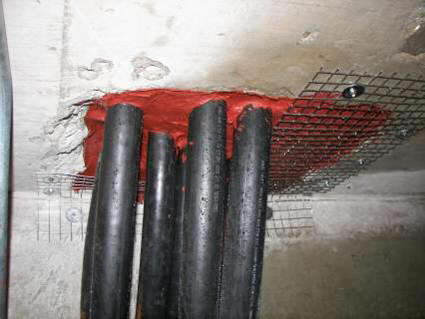Commercial Property Fire Protection: Firestops
by Nick Gromicko, CMI® and Kenton Shepard
A firestop is a passive fire-protection method designed to diminish the opportunity for fire to spread through unprotected openings in a rated firewall. Such openings are found around the perimeter of pipes and wiring that penetrate firewalls.

Places where firestops are required:
Firestops must seal all unprotected openings in firewalls. In homes, firewalls are found in the following locations:
Firestops must seal all unprotected openings in firewalls. In homes, firewalls are found in the following locations:
- between the garage and the living space, including the overhead ceiling;
- between the attic and the living space. Inspectors should be on the lookout for fireplace and wood stove flues that lack adequate fire-rated sheetrock or metal flashing firestopping, as in the photograph at right;
- firewalls that separate condominium units are often penetrated by utilities that serve multiple units. These utilities are sometimes contained inside chases that should be sealed where they pass through the firewall between units. Firewalls between units must be continuous, all the way to the roof. Inspectors should check in attics of multi-family dwellings to make sure that the firewall has not been violated in the attic space.
Common Problems With Firestops
InterNACHI inspectors should call out any instances where firestops are missing, damaged, or otherwise inadequate. Brief explanations of firestop deficiencies commonly encountered by inspectors are listed below:
InterNACHI inspectors should call out any instances where firestops are missing, damaged, or otherwise inadequate. Brief explanations of firestop deficiencies commonly encountered by inspectors are listed below:
- missing firestop: Unsealed pipe penetrations will greatly reduce the ability for a firewall to contain a fire. This situation is more common in old buildings than in new buildings, due to changes in building code.

- cable or pipe replacement: Electricians and plumbers may partially remove a firestop in order to install new cables and plumbing. A firewall’s fire-resistance rating will be compromised if the opening created by this removal is not filled.
- improper installation: Firestops will be effective only if they are installed correctly. For instance, firestop mortars are sometimes smeared into place unevenly and lack the required thickness at certain points. Also, firestops that are installed only on one side of a penetration may not be sufficient to prevent the spread of fire through the opening.
Common Firestop Materials
- firestop mortar: Cements made from lightweight aggregates, such as vermiculite or perlite, can be used as firestopping. They are typically colored to distinguish them from other types of cement that lack firestopping characteristics. For example, firestopping mortar made by Nelson is colored red, and 3M Fire Barrier Mortar is colored bluish-gray.
- intumescent: Any substance that expands as a result of heat exposure is considered an intumescent. Intumscents used as firestops can be made from a variety of flame-retardant materials, such as graphite, hydrates, and sodium silicates. They are especially useful firestopping materials for electrical cables, which can completely melt or burn away in a fire. The expanding intumes
 cent will partially or completely cover the exposed opening created by a melted wire.
cent will partially or completely cover the exposed opening created by a melted wire. - firestop pillows: These items contain various flame-retardant and intumescent substances, such as rockwool or graphite. They are filled loosely inside of a fiberglass fabric case that resembles a small pillow. Firestop pillows can be inserted into openings in firewalls and used in conjunction with other firestopping materials.
- sheet metal
- fire-rated sheetrock
In summary, firestops are designed to prevent the spread of fire through unprotected openings in rated firewalls. Inspectors should understand what they are and what purpose they serve.

